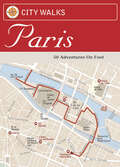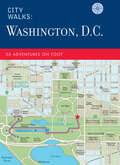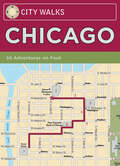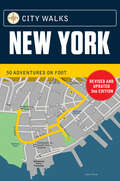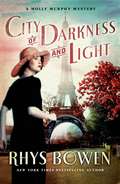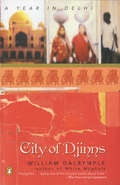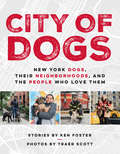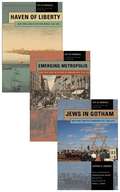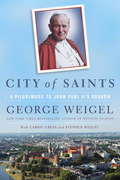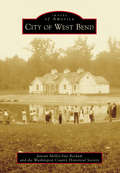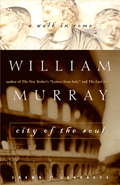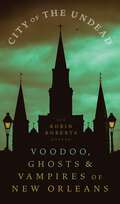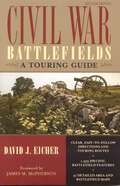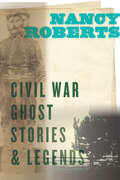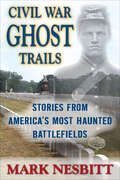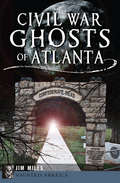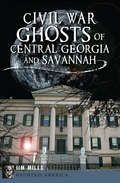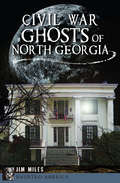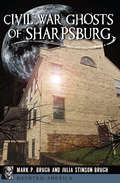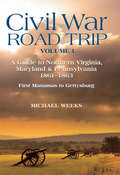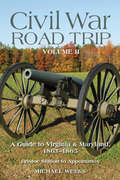- Table View
- List View
City Walks: 50 Adventures on Foot (City Walks)
by Christina Henry de Tessan Reineck And ReineckParis is a perfect city to explore à pied, and this ebook is designed for just that. On each page you'll find an illustrated map and, on the flip side, insider info on where to eat, drink, stop, and shop. With these 50 self-guided walking adventures you can explore historic sites, from the Arc de Triomphe to the Musée du Louvre, as well as uncover lesser-known gems, from open-air markets and intimate cafes to small museums with world-class art. Choose any page, and Paris is yours for the taking.
City Walks: 50 Adventures on Foot (City Walks)
by Christina Henry de TessanSkip the tour bus and experience the nation’s capital on foot with this guide to walkable Washington! City Walks: Washington, D.C. provides an insider’s view of the United States’ capital city, from historical landmarks to hot spots. Each page in this ebook outlines a self-guided walking adventure, complete with detailed map and local secrets. Pick any page and start exploring—and discover the best places to eat, drink, stop, shop, rest, walk, and play.
City Walks: 50 Adventures on Foot (City Walks)
by Christina Henry de TessanStroll the Magnificent Mile and more with fifty Chicago walking tours.Explore Chicago like a native with this convenient ebook offering maps and information to guide you through numerous enjoyable and enlightening walks that highlight both the history of this Midwestern city and the shopping, dining, and nightlife it offers.Discover landmarks like Millennium Park, the Loop, the Magnificent Mile, and Navy Pier—along with the many lesser-known local delights along the way!
City Walks: 50 Adventures on Foot (City Walks)
by Henry de TessanThe revised and updated third edition of the classic walking guide to San Francisco.This list of walking tours in San Francisco features brand new neighborhoods, restaurants, shops, and landmarks. Perfect for tourists exploring in the Bay Area, recent transplants, or even locals who want to become familiar with a new part of the city, this ebook shares the hidden gems of San Francisco. Each walk, from The Presidio to Japantown to the Embarcadero and the Exploratorium, is detailed with a full-color map, walking directions, and highlighted stopping points.
City Walks: 50 Adventures on Foot (City Walks)
by Henry de TessanThis city was made for walking—navigate the sidewalks of New York with this updated guide.Featuring brand-new walks, neighborhoods, restaurants, shops, and more, this revised guide reveals New York’s best-kept secrets as well as its best-known landmarks, from the Brooklyn Bridge to the High Line to the new Freedom Tower. Each of the fifty tours includes a full-color map, walking directions, and highlighted stopping points. It’s ideal for anyone who wants to make the most of NYC—be it transplant, traveler, or native.
City of Darkness and Light (Molly Murphy Mystery #13)
by Rhys Bowen[From the front dust jacket flap:] "Molly and Daniel Sullivan are settling happily into the new routines of parenthood, but their domestic bliss is shattered the night a gang retaliates against Daniel for making a big arrest. Daniel wants his family safely out of New York City as soon as possible. In shock and grieving, but knowing she needs to protect their infant son, Liam, Molly agrees to take him on the long journey to Paris to stay with her friends Sid and Gus, who are studying art in the City of Light. But upon arriving in Paris, nothing goes as planned. Sid and Gus seem to have vanished into thin air, and Molly's search to figure out what happened to them will lead her through all levels of Parisian society, from extravagant salons to the dingy cafés where starving artists linger over coffee and loud philosophical debates. And when in the course of her search she stumbles across a dead body, Molly, on her own in a foreign country, starts to wonder if she and Liam might be in even more danger in Paris than they had been at home. As Impressionism gives way to Fauvism and Cubism, and the Dreyfus Affair rocks France, Molly races through Paris to outsmart a killer in the most spectacular Molly Murphy novel yet. Catch up on all of the investigations of a feisty Irish immigrant in early twentieth century New York City. The historic atmosphere is diverse and accurate and though Molly enjoys her independence and is out to prove women are capable of running a business, she has a soft spot for Daniel, a police captain who loves her, but for some time, not reliably. Look for #0.5 The Amersham Rubies, #1 Murphy's Law, #2 Death of Riley, #3 For the Love of Mike, #4 In Like Flynn, #5 Oh Danny Boy, #6 In Dublin's Fair City, #7 Tell Me Pretty Maiden, #8 In A Gilded Cage, #9 The Last Illusion, #10 Bless the Bride, #11 Hush Now, Don't You Cry and #12 The Family Way, with more on the way.
City of Djinns: A Year in Delhi
by William DalrympleSparkling with irrepressible wit, City of Djinns peels back the layers of Delhi's centuries-old history, revealing an extraordinary array of characters along the way--from eunuchs to descendants of great Moguls. With refreshingly open-minded curiosity, William Dalrymple explores the seven "dead" cities of Delhi as well as the eighth city--today's Delhi. Underlying his quest is the legend of the djinns, fire-formed spirits that are said to assure the city's Phoenix-like regeneration no matter how many times it is destroyed. Entertaining, fascinating, and informative, City of Djinns is an irresistible blend of research and adventure.
City of Djinns: A Year in Delhi
by William DalrympleSparkling with irrepressible wit, City of Djinns peels back the layers of Delhi's centuries-old history, revealing an extraordinary array of characters along the way-from eunuchs to descendants of great Moguls. With refreshingly open-minded curiosity, William Dalrymple explores the seven "dead" cities of Delhi as well as the eighth city--today's Delhi. Underlying his quest is the legend of the djinns, fire-formed spirits that are said to assure the city's Phoenix-like regeneration no matter how many times it is destroyed. Entertaining, fascinating, and informative, City of Djinns is an irresistible blend of research and adventure.
City of Dogs: New York Dogs, Their Neighborhoods, and the People Who Love Them
by Ken Foster Traer ScottA beautiful, heartfelt, funny, and inspiring collection of photos and stories that maps the relationship between canine New Yorkers and their human counterparts.New York is a city of five boroughs, more than 250 distinct neighborhoods, 8.5 million people, and more than 600,000 dogs, who are as much a part of the social fabric as the people who follow them on the other end of the leash. City of Dogs maps this relationship with incredible four-color photos highlighting the scene.From the Bronx to Brooklyn and along the streets of Harlem and Manhattan, Ken Foster and Traer Scott explore the unique relationships between dogs and their human counterparts. We meet Alex Nuckel, living on disability and finding joy and purpose in caring for his two pit bulls, Lucy and Rocky. And Majora Carter, a community activist who has received a MacArthur grant, living and working with two stray shepherds she rescued in her own neighborhood. City of Dogs also takes us to a Midtown Manhattan law office, where staff are encouraged to bring their adopted dogs to work, and to the JFK airport, where we meet dogs who help screen at security. And then on to Brooklyn, where we meet award-winning author Jacqueline Woodson and her dogs, Toffee and Shadow. These are just a few of the amazing animals and their people featured in this perfect gift book for any dog lover.
City of Light: The Making of Modern Paris
by Rupert ChristiansenA sparkling account of the nineteenth-century reinvention of Paris as the most beautiful, exciting city in the world <P><P>In 1853, French emperor Louis Napoleon inaugurated a vast and ambitious program of public works in Paris, directed by Georges-Eugène Haussmann, the prefect of the Seine. Haussmann transformed the old medieval city of squalid slums and disease-ridden alleyways into a "City of Light" characterized by wide boulevards, apartment blocks, parks, squares and public monuments, new rail stations and department stores, and a new system of public sanitation. <P><P>City of Light charts this fifteen-year project of urban renewal which--despite the interruptions of war, revolution, corruption, and bankruptcy--set a template for nineteenth and early twentieth-century urban planning and created the enduring landscape of modern Paris now so famous around the globe. Lively and engaging, City of Light is a book for anyone who wants to know how Paris became Paris.
City of Promises: A History of the Jews of New York, 3-volume box set (City of Promises #3)
by Daniel Soyer Annie Polland Howard B. Rock Jeffrey S. Gurock Deborah Dash Moore Diana L. LindenWinner of the 2012 National Jewish Book Award, presented by the National Jewish Book CouncilNew York Jews, so visible and integral to the culture, economy and politics of America’s greatest city, has eluded the grasp of historians for decades. Surprisingly, no comprehensive history of New York Jews has ever been written. City of Promises: A History of the Jews of New York, a three volume set of original research, pioneers a path-breaking interpretation of a Jewish urban community at once the largest in Jewish history and most important in the modern world.Volume I, Haven of Liberty, by historian Howard B. Rock, chronicles the arrival of the first Jews to New York (then New Amsterdam) in 1654 and highlights their political and economic challenges. Overcoming significant barriers, colonial and republican Jews in New York laid the foundations for the development of a thriving community.Volume II, Emerging Metropolis, written by Annie Polland and Daniel Soyer, describes New York’s transformation into a Jewish city. Focusing on the urban Jewish built environment—its tenements and banks, synagogues and shops, department stores and settlement houses—it conveys the extraordinary complexity of Jewish immigrant society.Volume III, Jews in Gotham, by historian Jeffrey S. Gurock, highlights neighborhood life as the city’s distinctive feature. New York retained its preeminence as the capital of American Jews because of deep roots in local worlds that supported vigorous political, religious, and economic diversity.Each volume includes a “visual essay” by art historian Diana Linden interpreting aspects of life for New York’s Jews from their arrival until today. These illustrated sections, many in color, illuminate Jewish material culture and feature reproductions of early colonial portraits, art, architecture, as well as everyday culture and community.Overseen by noted scholar Deborah Dash Moore, City of Promises offers the largest Jewish city in the world, in the United States, and in Jewish history its first comprehensive account.
City of Saints
by George Weigel Stephen Weigel Carrie Gress"Karol Wojtyła, Pope John Paul II, was a man whose life was the expression of a richly textured and multidimensional soul. The many layers of that soul took on their first, mature form in Kraków." - George Weigel In this beautifully illustrated spiritual travelogue, New York Times bestselling author George Weigel leads readers through the historic streets of Kraków, Poland, introducing one of the world's great cities through the life of one of the most influential Catholic leaders of all time. "To follow Karol Wojtyła through Kraków is to follow an itinerary of sanctity while learning the story of a city." Weigel writes. "Thus, in what follows, the story of Karol Wojtyła, St. John Paul II, and the story of Kraków are interwoven in a chronological pilgrimage through the life of a saint that reveals, at the same time, the dramatic history and majestic culture of a city where a boy grew into a man, priest, a bishop--and an apostle to the world." With stunning photographs by Stephen Weigel and notes on the city's remarkable fabric by Carrie Gress, City of Saints offers an in-depth look at a man and a city that made an indelible impression on the life and thought of the Catholic Church and the 21st century world.From the Trade Paperback edition.
City of West Bend
by Janean Mollet-Van Beckum Washington County Historical SocietyThe City of West Bend got its name from its location on a large westward-reaching bend of the Milwaukee River. Settled mainly by German immigrants in the 1840s, the city was bestowed with leaders possessing entrepreneurial know-how. West Bend became an international center of manufacturing with companies such as the West Bend Aluminum Company, Enger-Kress Pocket Book Company, and Gehl Brothers Manufacturing. Knowing how to work hard, West Bend's residents also played hard with a booming downtown area, local sports teams, parks, and cultural entertainment. Recent decades have seen a decline of local industry, but unlike many communities, the historic downtown continues to thrive with shops, restaurants, and lively cultural offerings. Home to unique architecture such as Old Courthouse and Jail, beautiful Victorian homes, and the new Museum of Wisconsin Art, West Bend continues to thrive and take pride in its past while looking to the future.
City of the Soul
by William Murray“One lifetime is not enough for Rome,” the famous saying goes, and anyone who’s ever been there knows these words to be true. InCity of the Soul, William Murray begins to show us why. Growing up in Rome and spending much of his life in the city, William Murray is an expert guide as he takes us on an intimate walking tour of some of Rome’s most glorious achievements, illuminating the history and the mythology that define the city. Murray leads us through the centro, the city’s historic downtown center. He writes about the Villa Borghese, the Piazza di Spagna, and the Trevi Fountain and describes such singular attractions as the Capuchin Church of Santa Maria della Concezione, whose macabre crypt has impressed visitors from Mark Twain to the Marquis de Sade. As he walks, he reveals stories that only a longtime resident would know, capturing the sights, sounds, and flavors that make Rome a combination of the deep past and the ever-sensual present.
City of the Undead: Voodoo, Ghosts, and Vampires of New Orleans
by Robin Ann RobertsFrom its looming above-ground cemeteries to the ghosts believed to haunt its stately homes, New Orleans is a city deeply entwined with death, the undead, and the supernatural. The reasons behind New Orleans’s reputation as America’s most haunted city are numerous. Its location near the mouth of the Mississippi River grants it a liminal status between water and land, while its Old World architecture and lush, moss-covered oak trees lend it an eerie beauty. Complementing the city’s mysterious landscape, spiritual beliefs and practices from Native American, African, African American, Caribbean, and European cultures mingle in a unique ferment of the paranormal. An extremely high death rate in the eighteenth and nineteenth centuries and a long history of enslavement and oppression have also produced fertile soil for stories of the undead. Focusing on three manifestations of the supernatural in New Orleans—Voodoo, ghosts, and vampires—Robin Roberts argues that the paranormal gives voice to the voiceless, including victims of racism and oppression, thus encouraging the living not to repeat the injustices of the past.
Civic Monuments and the Augustales in Roman Italy
by Margaret L. LairdThe combination of portrait statue, monumental support, and public lettering was considered emblematic of Roman public space even in antiquity. This book examines ancient Roman statues and their bases, tombs, dedicatory altars, and panels commemorating gifts of civic beneficence made by the Augustales, civic groups composed primarily of wealthy ex-slaves. Margaret L. Laird examines how these monuments functioned as protagonists in their built and social environments by focusing on archaeologically attested commissions made by the Augustales in Roman Italian towns. Integrating methodologies from art history, architectural history, social history, and epigraphy with archaeological and sociological theories of community, she considers how dedications and their accompanying inscriptions created webs of association and transformed places of display into sites of local history. Understanding how these objects functioned in ancient cities, the book argues, illuminates how ordinary Romans combined public lettering, honorific portraits, emperor worship, and civic philanthropy to express their communal identities.
Civil War Battlefields: A Touring Guide
by David J. EicherHere, for the first time, is a book that goes beyond providing just a brief battle history for each of the Civil War parks. Civil War Battlefields presents a detailed, clear narrative describing exactly what visitors can see and do in twelve important battlefield areas covering 22 campaigns and approxiamately 40 separate battles.
Civil War Ghost Stories & Legends
by Nancy RobertsThe “First Lady of American Folklore” explores the supernatural side of the Civil War with chilling tales of spectral soldiers and haunted battlefields.Few events have sparked more legends and stories of the supernatural than America’s Civil War. The accounts of gallantry and heroism have spread far and wide. Nancy Roberts grew up listening to her father’s stories of the War Between the States and she trekked over many battle sites with him during her childhood.After reading about General Joshua Chamberlain’s supernatural experience at the Battle of Gettysburg, Roberts began to collect tales of the blue and gray and write them down. In her latest collection, readers visit such famous Civil War sites as Fredericksburg, Antietam, Johnson’s Island, Andersonville, Fort Davis, Gaines Mill, Gettysburg, Fort Monroe, Harpers Ferry, Vicksburg, Richmond, Charleston, New Bern, and Petersburg. Through these stories, the readers will hear the voices of those brave individuals who lived through that dramatic era; visit with Brigadier General J. E. B. Stuart on the banks of the Chickahominy River, learn the real story about John Brown’s activities at Harpers Ferry, and watch the passing of Abraham Lincoln’s funeral train.Praise for Nancy Roberts“Just about everybody likes a good ghost story. And ghost hunter/author Nancy Roberts has put together as shivery a selection of other worldly tales as you’re likely to find anywhere . . . And whether you believe in ghosts or not, these tales are guaranteed to give you a chill, especially before you go into a dark room alone.” —Southern Living
Civil War Ghost Trails: Stories from America's Most Haunted Battlefields
by Mark NesbittRiveting ghost stories with history from all the major engagements of the war.Civil War Ghost Trails examines the major engagements of the Civil War and their connections to the paranormal world. The history of each battlefield is followed by the classic ghost stories that have been around since the guns fell silent. Mark Nesbitt also collected newer stories and attempted a paranormal investigation, including Electronic Voice Phenomena (EVP), at many of the sites to see what could be found. In some cases, the results were astounding. Some of the spirits included in the book are the Headless Zouave at Bull Run, the Drummer Boy at Shiloh, and the Phantom Battalion at Gettysburg. Ghosts appear at the Bloody Lane at Antietam and Caroline Street in Fredericksburg, as well as sites at Chancellorsville, Vicksburg, Chickamauga, Chattanooga, Petersburg, and Appomattox Court House. A special section of the book explores the haunted Civil War prisons at Johnson&’s Island in Ohio, Point Lookout in Maryland, and Andersonville in Georgia. Abraham Lincoln&’s many White House apparitions are discussed in a section on wartime Washington, D.C.
Civil War Ghosts of Atlanta (Haunted America)
by Jim MilesThe author of the Civil War Explorer series unearths the ghostly legends and lore that haunt Georgia&’s capital city since the War Between the States. The Atlanta metropolis is one of America&’s most modern and progressive cities, it&’s easy to forget that 150 years ago it was the scene of a long and deadly campaign. Union general William T. Sherman hammered relentlessly against Atlanta at Kennesaw Mountain, Peachtree Creek, Ezra Church, and Jonesboro. Months later, as he began his infamous March to the Sea, much of Atlanta was destroyed by fire. Thousands died in the fighting, and thousands more succumbed to wounds and disease in large hospitals constructed around the city. Today, ghosts of Atlanta&’s Civil War haunt battlefields, hospital sites, cemeteries, homes, and commercial structures, all a testament to the tragic history of the city. Join author Jim Miles as he details the Civil War spirits that still haunt Atlanta. Includes photos! &“He&’s a connoisseur of Georgia&’s paranormal related activity, having both visited nearly every site discussed in his series of Civil War Ghost titles . . . Miles has covered a lot of ground so far from the bustling cities to the small towns seemingly in the middle of nowhere. This daunting task takes an inside look to the culture and stories that those born in Georgia grow up hearing about and connect with.&” —The Red & Black
Civil War Ghosts of Central Georgia and Savannah (Haunted America)
by Jim MilesThe historic battlefields of central Georgia and Savannah ensure that the state&’s Civil War ghosts shall rise again . . . and again . . . and again . . . The Heartland of Georgia, a vast region stretching from Columbus to Savannah and from the edge of Atlanta to Florida, is home to historic sites of Sherman&’s March to the Sea and Andersonville Civil War Prison. Because of this history, the area is one of the most haunted in the United States. All manner of paranormal phenomena haunt the battlefields, houses, prison sites, and forts throughout this region. Spirits even stalk the streets of Savannah, one of the most haunted cities in the world. Join author and historian Jim Miles as he details the past and present of the ghosts that haunt central Georgia and Savannah. Includes photos! &“He&’s a connoisseur of Georgia&’s paranormal related activity, having both visited nearly every site discussed in his series of Civil War Ghost titles . . . Miles has covered a lot of ground so far from the bustling cities to the small towns seemingly in the middle of nowhere. This daunting task takes an inside look to the culture and stories that those born in Georgia grow up hearing about and connect with.&” —The Red & Black
Civil War Ghosts of North Georgia (Haunted America)
by Jim MilesThe author of Haunted North Georgia stalks the Civil War ghosts that populate the top of the Peach State. Though Georgia was spared the hard hand of war for two years, combat arrived with a vengeance in September 1863 with the Battle of Chickamauga in north Georgia. It was the second largest battle of the Civil War and has become one of America&’s most haunted battlefields, producing a long history of bizarre paranormal events that continue today. From Sherman&’s notorious march to Confederate general James Longstreet&’s continued inhabitance of his postwar home, Georgia is haunted by many of those who fought in America&’s deadliest war. Join author Jim Miles as he details the ghosts that still roam Georgia&’s Civil War battlefields, hospitals, and antebellum homes. Includes photos! &“He&’s a connoisseur of Georgia&’s paranormal related activity, having both visited nearly every site discussed in his series of Civil War Ghost titles . . . Miles has covered a lot of ground so far from the bustling cities to the small towns seemingly in the middle of nowhere. This daunting task takes an inside look to the culture and stories that those born in Georgia grow up hearing about and connect with.&” —The Red & Black
Civil War Ghosts of Sharpsburg (Haunted America)
by Julia Stinson Brugh Mark P. BrughThe Maryland town devastated by the bloodiest day of the Civil War—the Battle of Antietam—is now home to its ghostly victims. In September 1862, fighting from the Battle of Antietam spilled into Sharpsburg&’s streets. Residents were left to bury the dead from both sides. Today, locals report lingering echoes of that strife, from the faint taps of a Union drummer boy named Charley King to the phantom footsteps of Confederate soldiers charging up the stairs of the Rohrbach House. Two spectral girls seen playing by the Big Spring in Children&’s Alley may be Savilla Miller and Theresa Kretzer, best friends torn apart by their divided loyalties. Tour guides Mark P. Brugh and Julia Stinson Brugh craft a vivid portrait of Sharpsburg in the Civil War and bring to light stories of the ghosts for whom the conflict never ended. Includes photos! &“Folklore, social history, and a haunted village . . . Provides brief discussions of the historic architecture and ironwork of the village and sketches of the effects of battle upon the civilian population . . . Overall, the authors have set the folklore of hauntings with the context of a major historical event.&” —Civil War Librarian
Civil War Road Trip, Volume I: First Manassas to Gettysburg (Vol #1)
by Michael WeeksThe new, amazingly detailed, and thorough guide from the author of The Complete Civil War Road Trip Guide. Although the Civil War was fought across America, the most captivating events for history buff s seem to be those that occurred in the relatively small region surrounding the two wartime capitals, Washington, DC, and Richmond, Virginia. In The Civil War Road Trip: A Guide to Northern Virginia, Maryland, and Pennsylvania, author Michael Weeks takes you on complete tours of every major military campaign in the region during the first two years of the war, from First Manassas in 1861 to Gettysburg in 1863. Weeks has visited every site included here, learning their vibrant stories and driving thousands of miles to bring readers the most accurate information. Detailed directions and maps for your own road trip, along with a blow-by-blow history of each campaign, will guide you to and through some of the war’s most critical battlegrounds, including Fredericksburg, Antietam, and the Shenandoah Valley. Travel tips, historic lodging places, and further sources of information are also included. Fully up to date and thoroughly researched, this guidebook is indispensable for travelers interested in America’s history.
Civil War Road Trip, Volume II: A Guide to Virginia & Maryland, 1863-1865 (Vol #2)
by Michael WeeksIn this second volume of Michael Weeks’ thoroughly researched guide to the battlefields of the Civil War, you will find complete tours of every major military campaign in the region from 1863 to 1865. In this second volume of Michael Weeks' thoroughly researched guide to the battlefields of the Civil War, you will find complete tours of every major military campaign in the region from 1863 to 1865, from the battles immediately following the great clash at Gettysburg to the fall of Richmond and the Appomattox campaign. Detailed directions and maps, along with a detailed history of each campaign, will guide you to and through some of the war's most critical battlegrounds, including The Wilderness, Spotsylvania, Cold Harbor, Petersburg, Lynchburg and the battle for Richmond. A section devoted to commands and commanders tells the life stories of the famous and the little-known; an explanation of military structure, orders of battle, and the various military units helps you keep track of the course of events and the key players. Travel tips and further sources of information are also included to help your explorations run smoothly.
